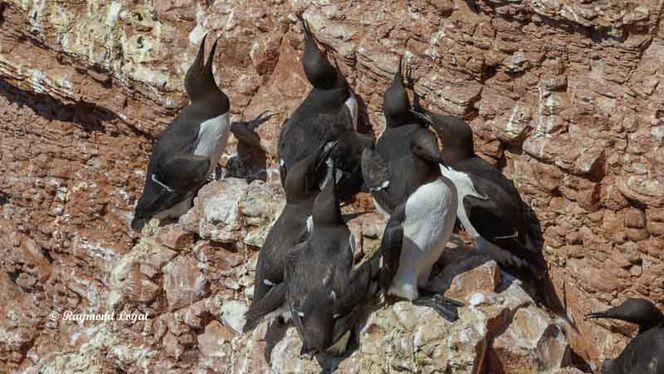Common Guillemot (Uria aalge)
The Common Guillemot is a species of the North Atlantic Auks and distributed across the nothern hemisphere. In north America it is called Common Mure. The breeding area stretches from the northern Pacific eastwards to the shores of the North Atlantic. The southern edge of the distribution area is marked by the breton coast and the island of Heligoland in the southern North Sea.

Description - Characteristics: Common Guillemot
Breeding – Clutch – Measurements – Habitat – Diet - Threats
Taxonomy:
Order: Charadriiformes
Family: Alcidae
Genus: Uria
Species: Common Guillemot
Scientific Name: Uria aalge
Names and Synonyms of the Common Guillemot
Name in German: Trottellumme
Name in Czech: Alkoun úzkozobý
Name in Slovak: Norec tenkozobý
Name in Hungarian: Lumma
Name in Croat: Tankokljuna njorka
Name in French: Guillemot marmette
Name in Spanish: Arao Común
Name in Portuguese: Arau-comum
Name in Dutch: Zeekoet
Name in Italian: Uria
Name in Iceland: Langvía
Name in Faroer: Lomviga, Lomvigi, Skjóringur
Name in Greenland: Appa sigguttooq
Name in North Sami: Skárfacielkkis
Name in Finnish: Etelänkiisla
Name in Danish: Lomvie
Name in Swedish: Sillgrissla
Name in Polish: Nurzyk
Name in Russian: Тонкоклювая кайра
Distribution – Movements – Habitat - Behaviour
Distribution: North Atlantic and North Pacific; Labrador, Newfoundland to Iceland, Scotland, Norway, Baltics, Denmark, Sweden, Finland, Russia; Heligoland, Great Britain, Ireland, Channel Islands, Svalbard, Faroe .
Movements: Migratory.
Habitat: Lives out on the open seas, returns to land only during breeding seasons.
Behaviour: Activity during daylight and twilight. Bad flying abilities. Ability to run and walk over short distances. Dives with maximum diving depths of 100-120 m!.
Field Characteristics:Head and upperparts brownish (not black!), underparts white. Bridled variety with ring around the eye. Sits upright. Slender body with pointed bill. Narrow short pointed wings. Can be confused with Brünnich’s Guillemot when breeding in same area.
Bill: dark, pointed.
Tarsus: dark.
Iris: dark.
Measurements
Size: 38-43 cm
Weight:
♂ in winter: 490-844 g
♀ in winter: 561-863 g
Wingspan: 64-71 cm
Wing:
♂: 22.0-22.6 cm
♀: 20.4-22.4 cm
Voice: Vocal in colony, utters sounds like “mmm”, hard and nasal notes like “ha-ha-ha”, also “ha-aahr” etc..
Breeding
Maturity: during 5th year, during 4th year at the earliest.
Mating Season: monogamous breeding pair, very loyal to nest site and also to former partner.
Clutches per breeding season1 clutch
Breeding: mainly in May, April at the earliest, on Faroe between May and end of June, Barents Sea between mid-May and end of June.
Nest: No nest building. Egg is placed on feet. Nest site on exposed ledges, cornices, plateau, small outcrops. Always high density of breeding birds on ledges.

Clutch: 1 egg
Eggs: circular and pointed, base colour white, grey, greenish, brown and dark green-blue, with a variety of speckle patterns.
Egg Measurements:
Length: 72.5-92.7 mm
Width: 44.0-53.6 mm
Ø: 81.5x49.7 mm
Egg weight: c. 105.0-125.0 g
shell weight: 9.09-14.34 g; Ø = 12.3 g (n=100)
Recurrent Clutch: up to two recurrent clutches, when lost during early days.
Incubation: 30-35 (28-45) days, both parents share the task of incubating. Bird incubate with its back to the abyss, making it difficult for partners to relieve each other.
Fledging: altrical chicken, always in the company of one parent. Adults spread wings when feeding juvenile to prevent others from stealing food. After 18-24 days juveniles jump off the cliff. At that stage the juveniles are still not fully grown, their wings are still growing and they cannot fly. They just spread their wings and plummet down to the ground, aiming for the seas below. The juveniles surviving that jump are led by parents to the water surface. Jump mostly happens during late evening. Juveniles can immediately swim and are accompanied by parents.
Dependency: It takes another 10 weeks, after jumping off the cliff, for the juvenile to fledge. At that time they are still fed, at least by one parent.
Miscellaneous
Food: pelagic schooling fish, sprats, herring, sandeels, cod. Sizes of catched fish mainly 90-125 mm.
Longevity: Common guillemots can reach an age of >22 years, >23 years and >32 years.
Mortality: Mortality amongst juveniles until maturity is reached stands at c. 60-80%. Birds after first breading season: mortality c. 3.3-7.6%; survival rate: ca. 91.5%. In order to keep the population alive, about 24% of all fledged juveniles must survive.
Threats: Oil pollution, especially after accidents on the seas. People collecting eggs on Faroe, in Norway and Great Britain. Losses by drowning in fishing nets. Overfishing especially on sprats, sandeels and herrings. High levels of heavy metals and pesticides. Disturbances at colonies.
References
Bauer, Hans-Günther, Bezzel, Einhard et. al. (HG), Kompendium der Vögel Mitteleuropas, Volume 1+2, Sonderausgabe 2012, Aula Verlag, Wiebelsheim
Bauer, Hans-Günther, Bezzel, Einhard et. al. (HG), Kompendium der Vögel Mitteleuropas, Volume 3, Literatur und Anhang, Aula Verlag Wiebelsheim, 2. vollständig überarbeitete Auflage 1993
Bezzel, Einhard, Kompendium der Vögel Mitteleuropas, Non-Passeriformes, Volume 1, AULA-Verlag Wiesbaden, 1985
Bruun/Singer/König/Der Kosmos Vogelführer, Franck'sche Verlagshandlung Stuttgart, 5. Auflage 1982
Glutz von Blotzheim, Urs et. al (HG), Handbuch der Vögel Mitteleuropas, Vol 8/II, Charadriiformes (Part 3), Akademische Verlagsgesellschaft Wiesbaden, 1982
Svenson, Lars et. al, Collins Bird Guide, Harper Collins London, 2009, revised and reprinded 2021
Image Credits
Egg of Common Guillemot - Source: by Klaus Rassinger und Gerhard Cammerer, Museum Wiesbaden - own works, CC BY-SA 3.0, https://commons.wikimedia.org/w/index.php?curid=36817451
